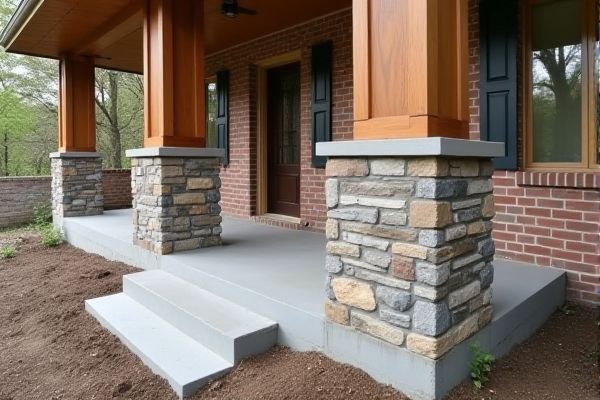
Brick piers offer a classic, uniform appearance and are typically easier and faster to construct, while stone piers provide superior durability and a natural, rustic look that can enhance curb appeal. Explore the full comparison to determine which porch foundation best suits your home's style and structural needs.
Table of Comparison
| Feature | Brick Piers | Stone Piers |
|---|---|---|
| Material Composition | Manufactured clay bricks | Natural quarried stone |
| Durability | Moderate; prone to weathering and mortar degradation | High; resists weathering and erosion effectively |
| Load-Bearing Capacity | Good for standard porch loads | Excellent; suitable for heavy loads |
| Installation Complexity | Relatively simple and faster | More labor-intensive and time-consuming |
| Maintenance | Requires frequent mortar joint repairs | Low maintenance, natural resistance |
| Cost | Generally more affordable upfront | Typically more expensive due to labor |
| Aesthetic Appeal | Uniform look; classic design | Rustic and natural appearance |
| Environmental Impact | Manufactured with higher carbon footprint | Eco-friendly using natural local materials |
Introduction to Porch Foundation Types
Brick piers provide a durable and cost-effective option for porch foundations, offering strong support through solid masonry units arranged in columns. Stone piers feature natural aesthetics and exceptional strength due to the irregular shapes and textures of quarried stone, enhancing curb appeal while ensuring stability. Your choice between brick and stone piers depends on the architectural style of your home, budget, and desired longevity for the porch foundation.
What Are Brick Piers?
Brick piers are vertical support structures made from stacked bricks bonded with mortar, often used in porch foundations to provide stability and elevate the structure above ground level. They offer a durable and cost-effective alternative to stone piers, featuring uniform size and shape for easier construction and aesthetic consistency. Brick piers also resist moisture and pests effectively, making them suitable for various climates and foundation needs.
What Are Stone Piers?
Stone piers are structural supports used as porch foundations, constructed from natural or cut stone blocks stacked and bonded with mortar for durability and stability. These piers provide a robust, weather-resistant base that evenly distributes the porch's weight and enhances its aesthetic appeal with a rustic or traditional look. Compared to brick piers, stone piers offer superior resistance to moisture and temperature fluctuations, making them ideal for long-lasting outdoor installations.
Construction Process: Brick vs Stone Piers
Brick piers involve stacking uniformly shaped bricks with mortar to create a strong, consistent foundation, allowing for precise alignment and faster construction. Stone piers require selecting and fitting irregularly shaped stones, which makes the process labor-intensive and demands skilled craftsmanship to ensure stability. Your choice between brick and stone piers impacts the construction timeline, structural integrity, and overall aesthetic of your porch foundation.
Strength and Durability Comparison
Brick piers offer moderate strength and durability, suitable for supporting lighter porch structures but may require more frequent maintenance due to potential mortar erosion and weathering. Stone piers provide superior strength and long-lasting durability, with natural resistance to weather, pests, and heavy loads, making them ideal for robust porch foundations. The inherent density and hardness of stone contribute to its ability to withstand environmental stresses better than brick over time.
Cost Analysis: Brick Piers vs Stone Piers
Brick piers generally offer a more budget-friendly option for porch foundations, with average costs ranging from $10 to $25 per square foot, compared to stone piers which typically range from $20 to $40 per square foot due to higher material and labor expenses. Brick piers require less specialized labor and can be constructed faster, reducing overall installation costs, while stone piers involve intricate masonry work that elevates both time and price. Maintenance expenses for brick piers are usually lower, as stone piers may need periodic sealing and repairs to address weather-related erosion or cracking.
Maintenance Requirements
Brick piers require regular inspection for mortar deterioration and potential spalling due to moisture exposure, with repointing needed every 10-15 years to maintain structural integrity. Stone piers generally demand less frequent maintenance, as natural stone resists weathering and erosion better, but occasional resetting of loose stones and repointing of mortar joints may be necessary over several decades. Both types benefit from preventative sealing and drainage measures to minimize water infiltration and prolong foundation stability.
Aesthetic Appeal and Design Flexibility
Brick piers offer a classic, uniform aesthetic with clean lines and a range of color options that complement traditional and modern porch designs. Stone piers provide a more rustic, natural look with unique textures and irregular shapes, enhancing curb appeal through organic charm and visual interest. Your choice depends on the desired style and the level of design flexibility needed to match your home's architectural character.
Climate and Environmental Considerations
Brick piers offer better resistance to moisture in humid climates due to their dense composition and mortar sealing, reducing the risk of water infiltration and structural damage. Stone piers excel in colder environments because natural stone withstands freeze-thaw cycles more effectively, preventing cracks and deterioration. Your choice between brick and stone piers should factor in local climate conditions to ensure long-lasting porch foundation stability.
Choosing the Right Pier for Your Porch
Brick piers offer durability and classic aesthetic appeal, ideal for traditional porch designs, while stone piers provide a rustic, natural look with exceptional strength and weather resistance. Selecting the right pier depends on factors such as soil conditions, climate, load requirements, and architectural style. Proper material choice ensures long-lasting stability, supports the porch structure effectively, and enhances curb appeal.
 homyna.com
homyna.com